 W
WThe visible remains of an amphitheatre constructed during Roman London lie beneath the Guildhall Art Gallery complex in the City of London. Some of these remains are displayed in situ in a room in the basement of the art gallery. Discovered in 1988, the site is now a scheduled monument.
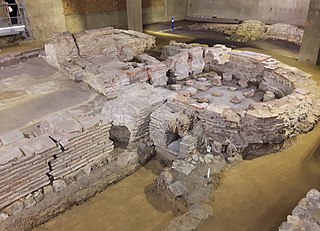 W
WBillingsgate Roman House and Baths is an archaeological site in Londinium. The best preserved parts of the house are a bath with hypocausts. The ruins were discovered in 1848 while the Coal Exchange was built on the site. The remains were preserved and were visible in the cellar of the building. In 1967 to 1970, the Coal Exchange was replaced by another building and the Lower Thames Street was enlarged. Further excavations were made at the site and the remains were incorporated into the cellar of the new building, but were not open to the public.
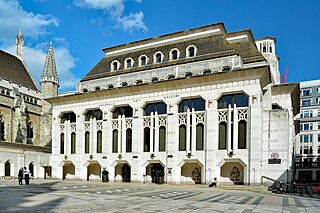 W
WThe Guildhall Art Gallery houses the art collection of the City of London, England. It is a stone building in a semi-Gothic style intended to be sympathetic to the historic Guildhall, which is adjacent and to which it is connected internally.
 W
WGuildhall is a municipal building in the Moorgate area of the City of London, England. It is situated off Gresham and Basinghall streets, in the wards of Bassishaw and Cheap. The building has been used as a town hall for several hundred years, and is still the ceremonial and administrative centre of the City of London and its Corporation. It should not be confused with London's City Hall, the administrative centre for Greater London. The term "Guildhall" refers both to the whole building and to its main room, which is a medieval great hall. The nearest London Underground stations are Bank, St Paul's and Moorgate. It is a Grade I-listed building.
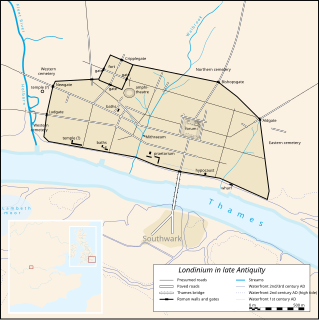 W
WLondinium, also known as Roman London, was the capital of Roman Britain during most of the period of Roman rule. It was originally a settlement established on the current site of the City of London around AD 47–50. It sat at a key crossing point over the River Thames which turned the city into a road nexus and major port, serving as a major commercial centre in Roman Britain until its abandonment during the 5th century.
 W
WThe London Mithraeum, also known as the Temple of Mithras, Walbrook, is a Roman mithraeum that was discovered in Walbrook, a street in the City of London, during a building's construction in 1954. The entire site was relocated to permit continued construction and this temple of the mystery god Mithras became perhaps the most famous 20th-century Roman discovery in London.
 W
WThe London Wall was the defensive wall first built by the Romans around Londinium, their strategically important port town on the River Thames in what is now London, England, and subsequently maintained until the 18th century.
 W
WNo 1 Poultry is an office and retail building in London. It is located at the junction of Poultry and Queen Victoria Street, adjacent to Bank junction, in the City of London financial district. The building was designed by James Stirling for a site which then was owned by developer Peter Palumbo, and first assembled by Palumbo's father, Rudolph, in the 1960s. It was originally intended to be the site of a modernist office tower designed by Ludwig Mies van der Rohe in the manner of the Seagram Building in New York City, but that scheme was aborted following one of the great architectural and planning show-downs of the 1970s. A new design was created, Stirling's final design, in a postmodernist style with an outer shell of bands of rose-pink stone. The structure was built after his death and is considered one of the greatest masterpieces of the postmodernist style in London. In 2016, following proposals to alter it, it received government recognition with a listing at grade II*, making it the youngest listed building in England.
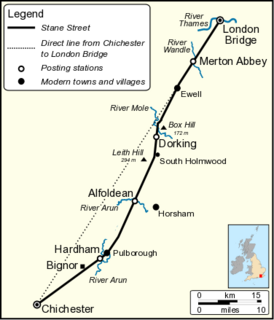 W
WStane Street is the modern name given to an important 90 km-long (56 mi) Roman road in southern England that linked Londonium (London) to Noviomagus Reginorum (Chichester). The exact date of construction is uncertain; however, on the basis of archaeological artefacts discovered along the route, it was in use by 70 AD and may have been constructed in the first decade of the Roman occupation of Britain.
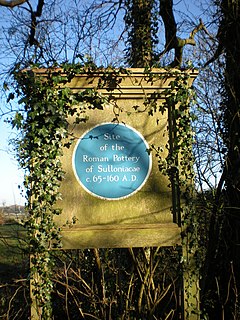 W
WSulloniacis or Sulloniacae is the name of a place in Roman Britain which is known only from an entry in the Antonine Itinerary, a listing of routes and facilities for the cursus publicus, the official courier service of the Roman Empire. Iter (Itinerary) II of the British section runs between Richborough and Chester (Deva), and this shows Sulloniacis on the road now known as Watling Street, nine Roman miles from St Albans (Verulamium) and 12 from London. Sulloniacis is usually identified with Roman remains found at Brockley Hill near Edgware in the London Borough of Barnet.